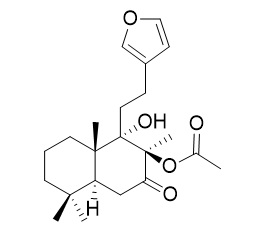Galeopsin
Galeopsin shows potential anti-inflammatory activity by inhibiting proinflammatory cytokine TNF-α, it has anti-proliferative effect on several cancer cell lines.
Inquire / Order:
manager@chemfaces.com
Technical Inquiries:
service@chemfaces.com
Tel:
+86-27-84237783
Fax:
+86-27-84254680
Address:
1 Building, No. 83, CheCheng Rd., Wuhan Economic and Technological Development Zone, Wuhan, Hubei 430056, PRC
Providing storage is as stated on the product vial and the vial is kept tightly sealed, the product can be stored for up to
24 months(2-8C).
Wherever possible, you should prepare and use solutions on the same day. However, if you need to make up stock solutions in advance, we recommend that you store the solution as aliquots in tightly sealed vials at -20C. Generally, these will be useable for up to two weeks. Before use, and prior to opening the vial we recommend that you allow your product to equilibrate to room temperature for at least 1 hour.
Need more advice on solubility, usage and handling? Please email to: service@chemfaces.com
The packaging of the product may have turned upside down during transportation, resulting in the natural compounds adhering to the neck or cap of the vial. take the vial out of its packaging and gently shake to let the compounds fall to the bottom of the vial. for liquid products, centrifuge at 200-500 RPM to gather the liquid at the bottom of the vial. try to avoid loss or contamination during handling.
Pharmaceuticals (Basel).2024 Feb 24;17(3):292.
J Am Soc Mass Spectrom.2021, 32(9):2451-2462.
Nat Commun.2023, 14(1):8142.
Genes (Basel).2021, 12(7):1024.
Tumour Biol.2015, 36(9):7027-34
Applied Physics B2021, 127(92).
Journal of Ginseng Research2019, 10.1016
FEBS J.2022, 10.1111:febs.16676.
Foods.2023, 12(2):318.
Proc Natl Acad Sci USA.2016, 113(30):E4407-1
Related and Featured Products
Phytochem Anal. 2017 Sep;28(5):404-409.
Localisation of Two Bioactive Labdane Diterpenoids in the Peltate Glandular Trichomes of Leonurus japonicus by Laser Microdissection Coupled with UPLC-MS/MS.[Pubmed:
28485033 ]
Glandular trichomes of plants are biochemical factories that could produce, store and secrete copious pharmaceutically important natural products. The Labiatae plant Leonurus japonicus is an important traditional Chinese medicine used to treat gynecological diseases, and has abundant peltate glandular trichomes (PGTs), in which the secondary metabolites accumulated are still unknown.
To study the secondary metabolites specifically accumulated in the PGTs of L. japonicus and their biological activities, and provide a new way to pinpoint bioactive natural products from plants.
METHODS AND RESULTS:
Morphology of the trichomes on L. japonicus were observed under a scanning electron microscope. The PGTs of L. japonicus were precisely collected using laser microdissection (LMD) and analysed for their secondary metabolites with ultra performance liquid chromatography-tandem mass spectrometry (UPLC-MS/MS). Targeted compounds were isolated with classical phytochemical methods, and their structures were elucidated by spectroscopic analysis. Biological activities were evaluated by in vitro assays.
Two labdane diterpenoids, leoheterin (1) and Galeopsin (2), were localised in the PGTs of L. japonicus. Antithrombotic activity of 1 in anti-platelet aggregation assay induced by arachidonic acid was observed. Both compounds showed potential anti-inflammatory activity by inhibiting proinflammatory cytokine TNF-α. In addition, anti-proliferative effect of both compounds on several cancer cell lines was also detected.
CONCLUSIONS:
Two bioactive labdane diterpenoids were localised in the PGTs of L. japonicus. The findings suggested that it might be an efficient approach to explore bioactive natural products from the glandular trichomes of medicinal plants with LMD-UPLC/MS/MS.
Chem Pharm Bull (Tokyo). 2005 Nov;53(11):1475-9.
New bis-spirolabdane-type diterpenoids from Leonurus heterophyllus Sw.[Pubmed:
16272737]
METHODS AND RESULTS:
Twelve natural bis-spirolabdane-type diterpenoids, including eight new, named leoheteronones A-E, 15-epileoheteronones B, D, and E, and four known leopersin B, 15-epileopersin B, leopersin C, and 15-epileopersin C, together with hispanone and Galeopsin were isolated from the aerial parts of the medicinal plant Leonurus heterophyllus SW. (Lamiaceae) grown in Vietnam. Their structures were determined by spectroscopic analyses.
CONCLUSIONS:
The current study emphasized the accumulation of C-15 oxygenated bis-spirolabdane-type diterpenoids of both 13R and 13S configurations in L. heterophyllus.



